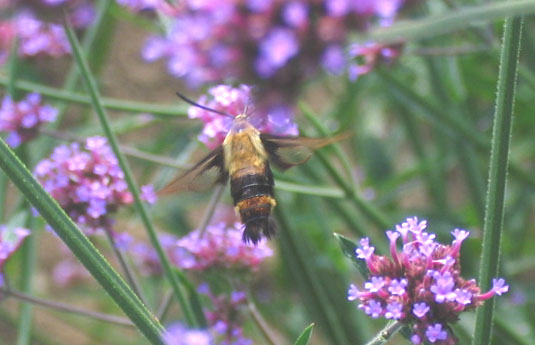Sphinginae subfamily
Sphingini tribe:
 |
Ceratomia amyntor WO,
the Elm Sphinx or Four-horned Sphinx
This moth is not officially recorded in Hampshire, but it
has been taken in all surrounding states nearby and in Berkshire County.
Larvae feed on Elm (Ulmus), birch (Betula), basswood (Tilia), and cherry (Prunus).
|
 |
This is generally a more southerly species, but it has been recorded
in Essex County.
I saw them in great numbers in New Jersey. The larvae feed in large groups and are much more
spectacular than the moths.
Catalpa is the larval host. Questionable!
|
 |
This moth is now officially recorded in Hampshire, courtesy of
Barbara Spencer.
It is named for the wavy lines on the forewings.
Note black and white collar separating thorax from abdomen. |
Ceratomia undulosa,
June 7-9, 2004; July 7, 2004; Barbara Spencer.
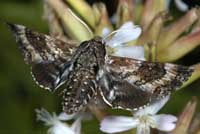 |
This moth is not officially recorded in Hampshire, but
it has been taken to the north, east, south and west. Larvae are not limited to pawpaw.
|
 |
Lapara bombycoides USGS/BH/JSR,
the Northern Pine Sphinx
Reported from Hampshire, it is widely
reported in Massachusetts and along the coast in New Hamshire and
Vermont. This is another one we have on P.E.I.
|
Lapara bombycoides adult moth, Florence, June 5, 2010, courtesy of Betsy Higgins.
 |
Although not officially reported from Hampshire, it is widely
reported in Massachusetts and along the coast in New Hamshire and Vermont.
If you've got pines, this species is likely present.
|
 |
This species is probably present in Hamsphire County.
The upperside of the forewing is gray-brown with wavy lines, black dashes, and one or
two small white spots near the center of the costa.
|
 |
This species is not officially recorded in Hampshire.
This moth usually is not found north of Connecticut, but it might be found in southern Hamsphire County as it is
a strong flier.
|
 |
This species is not recorded in Hamshire, but, if you
grow tomatoes, you have probably encountered it.
|
 |
This species is not officially recorded in Hampshire, but if you grow
tomatoes, you have probably encountered it.
Larvae get very large and can strip a tomato plant.
|

|
Sphinx canadensis
WO,
Sphinx canadensis, the Canadian Sphinx, is not common, and is not
often reported anywhere,
but it might be present in Hampshire County as it is reported from
Berkshire.
Larval hosts are white ash (Fraxinus americana) and blueberry
(Vaccinium).
|
 |
Sphinx chersis WO, the Northern Ash Sphinx or Great Ash Sphinx
This species is probably present in Hampshire County.
Larval hosts are ash, lilac, privet, cherry, and quaking aspen.
|
 |
This species is not officially recorded, but I suspect it is present. We have
them on P.E.I., but I do not see them nearly as frequently
as I see the other Sphingidae.
|
 |
This species is probably present in Hampshire County.
Colouration and markings are highly variable from one specimen to
another. The fringes on forewing are mostly
black with some white; those on the hindwing are mostly white with a
few black patches. |
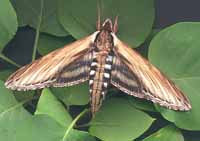 |
This species is not reported in Hampshire, but is confirmed in nearby counties.
I have taken them on P.E.I., Canada, and reared them on
lilac. At rest the hindwings are usually completely covered.
|
 |
Sphinx luscitiosa
WO,
the Canadian Sphinx or
Clemen's Sphinx
This one is not officially reported from Hamsphire, but it should be present.
|
 |
Sphinx poecila USGS/JSR, the Poecila Sphinx
If you have blueberries in the woods, then you probably have the Poecila Sphinx.
They are pretty common here on Prince Edward Island, but don't fly
too far south of Massachusetts, being replaced by Sphinx gordius
in Connecticut. |
Smerinthini Tribe:
 |
This moth is also fairly widely reported to the north, east, south
and west of Hampshire, so should be present.
This is the first Sphinx species I reared as a boy in New Jersey.
See the file for the female; she is different. |
 |
Pachysphinx modesta WO/BS
the Modest Sphinx or Poplar Sphinx
This moth is found to the north, east, south and west of Hampshire
so it is probably present there too (now
confirmed by Barbara Spencer). |
Pachysphinx modesta, June 7, 2004, Barbara Spencer.
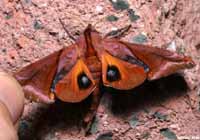 |
It is recorded for northeastern Massachusetts and western Connecticut
so may be present in Hampshire.
It would be more common
in southeastern Massachusetts and is a relatively uncommon species.
|
 |
Named for the dull grey-blue spot in the hindwing, this moth has a
wide distribution and is probably common in Hampshire County.
I regularly see them on Prince Edward Island, and they are reported as far south as Florida.
|
Paonias excaecata, Cummington, July 9, 2004, Barbara Spencer.
Paonias excaecata, Florence, July 23, 2009; July 2, 2011, Betsy Higgins
 |
Paonias myops
WO/BS, the Small-eyed Sphinx
Named for the small eye-spot in the hindwing, this moth has a wide distribution
and is probably common in Hampshire County.
I regularly see them on Prince Edward Island, and they are reported as far south as Florida.
|
Paonias myops, Barbara
Spencer.
 |
Reported in Berkshire and Essex, it is probably also in Hampshire near the southern limit of its eastern range.
I never saw
one in New Jersey. At my home in Montague, P.E.I., Canada, they are quite common. |
 |
This moth is widely distributed and fairly common so I suspect it is
in Hampshire County.
Along the East Coast, it flies from P.E.I. to Florida. |
Macroglossinae subfamily
Dilophonotini tribe:
 |
Hemaris thysbe
WO/BS, the Hummingbird Clearwing
This interesting day flier is now confirmed for Hampshire,
courtesy of Barbara Spencer.
They are widely distributed in the east from P.E.I. to Florida. |
Hemaris thysbe, June 21, 2004, Cummington, Barbara Spencer.
Hemaris thysbe, June 11, 2006, Cummington, Barbara Spencer.
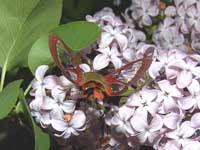 |
Hemaris gracilis
WO/BS,
The Slender Clearwing or Graceful Clearwing
This day flier is not commonly reported, but has been confirmed
by Barbara Spencer. |
See Hemaris comparison, June 9, 2004, Cummington, Barbara Spencer.
 |
Hemaris diffinis
BS, the Snowberry Clearwing or Bumblebee Moth
This moth is widely distributed and is confirmed by Barbara Spencer
for Hampshire.
|
See Hemaris comparison,
August 13, 2005, Northampton, Barbara Spencer.
Philampelini tribe:
 |
This moth is not officially reported for Hampshire,
but it is fairly often reported
along the coast from southern New Jersey
to central Maine.
Note the differences between this moth and the Pandorus Sphinx. |
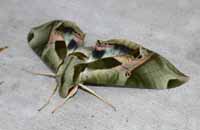 |
If you have Grape or Virginia Creeper nearby, then you probably have
this species.
I often get asked to identify larvae from areas where they have not
previously been reported.
It is confirmed in Worcester Co. to the east. |
Macroglossini tribe:
 |
This day flier is widely distributed in surrounding states and in
eastern Massachusetts.
If you have Virginia Creeper, you
probably have the Nessus Sphinx.
Two bright, distinct, narrow yellow
bands are often visible on the abdomen.
|
Amphion floridensis, Chesterfield and Cummington, Barbara Spencer
Amphion floridensis, June 11, 2006, Cummington, Barbara Spencer.
 |
They are common in New Jersey and common
here on Prince Edward Island.
You will often see this species listed as Darapsa pholus,
especially in older literature. It is almost certainly present. |
 |
Darapsa myron
WO/JSR,
the Virginia Creeper Sphinx or the Grapevine Sphinx
This moth is not recorded on the U.S.G.S. site for Hampshire County.
It is widely reported as far north as southern Maine. If you have the foodplants
indicated in the common names, you probably have this species nearby. |
 |
If you have hydrangea growing near a stream, then you may have the
Hydrnagea Sphinx. It has not been widely reported, however, and
probably is uncommon.
|
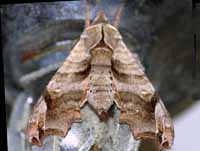 |
This species has been recorded in most of the surrounding
Massachusetts counties.
It should be present. |
 |
Hyles gallii
WO/BS,
the Bedstraw Hawk Moth
or Gallium Sphinx
This species is reported in Essex and Berkshire and should be
present. It has been confirmed in Hampshire County by Barbara Spencer.
Some years I see them on P.E.I., some years, I do not.
|
 |
Hyles lineata WO, the White-lined Sphinx
This species is reported in Essex and Berkshire and should be
present.
It is a strong migrator from the south,
and there are records from the east, west and to the north. |
 |
This moth is very much under reported. It is a
rapid day flier so is probably not in too many collections. Grape is a popular larval host.
|
|
|
